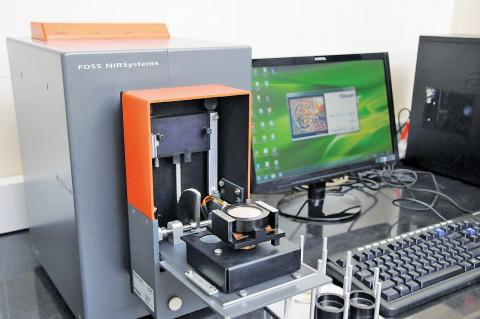7.17 Analysis using near infrared analyser (NIR)
Principle
The sample representing the chemical composition of the sample material is measured by NIR spectrometry. Spectral data in the near infrared are collected and transformed to constituent or parameter concentrations by calibration models developed on representative samples.
Near infrared (NIR) instrument
NIR instrument (Fig. 7.14) based on diffuse reflectance or transmittance measurement in the near infrared wavelength region of 700-2500 nm or segments of this or at selected wavelengths. The optical principle may be dispersive (e.g. grating mono-chromators) interferometric or non-thermal (e.g. light emitting diodes, laser diodes and lasers). The instrument should be provided with a diagnostic test system for testing photometric noise and reproducibility, wavelength accuracy and wavelength precision (for scanning spectrophotometers). The instrument should measure a sufficiently large sample volume or surface to eliminate any significant influence of in homogeneity derived from chemical composition or physical properties of the test sample. The sample path length (sample thickness) in transmittance

Fig. 7.14 Near infrared analyzer
measurements should be optimized according to the manufacturer’s recommendation with respect to signal intensity for obtaining linearity and maximum signal/noise ratio. In reflectance measurements, a quartz window or other appropriate material to eliminate drying effects should preferably cover the interacting sample surface layer.
Sampling
It is important that the laboratory receives a sample which is truly representative and has not been damaged or changed during transport or storage. All laboratory samples should usually be kept under conditions that will not change the composition of the sample from the time of sampling to the time of commencing the procedure.
Procedure
Preparation of test sample
The preparation of samples should be made in the same way as the preparation of the validation samples. It is necessary to apply standard conditions. Before the analysis, the sample should be taken in such a way as to obtain a sample representative of the material to be analysed.
Measurement
Follow instructions for the specific NIR instrument and associated calibrations. The prepared sample should reach a temperature within the range included in the validation.
Evaluation of result
For the validation results to be valid, they have to be within the range of the calibration model used. Results obtained on samples detected as spectral outliers cannot be regarded as reliable.
Checking instrument stability
Control sample
At least one control sample should be measured at least once per day to check instrument hardware stability and to detect a malfunction. Knowledge of the true concentration of theanalyte in the control sample is not necessary. The sample material should be stable and, as far as possible, resemble the samples to be analysed. The parameter(s) measured should be stable and, as far as possible identical to or at least biochemically close to the sample analyte. These samples are normally stable for lengthy periods but the stability should be tested in the actual cases. Shifts between control samples should be overlapped to secure uninterrupted control. The recorded day-to-day variation should be plotted in control charts and investigated for significant patterns or trends.
Instrument diagnostics
For spectrophotometers the wavelength accuracy and precision should be checked at least once per week, or more frequently if recommended by the instrument manufacturers, and the results should be compared to specifications and requirements. A similar check of the instrument noise should also be carried out weekly, or at intervals recommended by the manufacturer.
Running performance check of calibration
NIR methods should be validated continuously against reference methods to secure steady optimal performance of calibrations and observance of accuracy. The frequency of checking the NIR method should be sufficient to ensure that the method is operating under steady control with respect to systematic and random deviations from the reference method. The frequency depends on the number of samples analysed per day and the rate of changes in sample population.
The running validation should be performed on samples selected randomly from the pool of analysed samples.
It may be necessary to resort to some sampling strategy to ensure a balanced sample distribution over the entire calibration range, e.g. segmentation of concentration range and random selection of test samples within each segment or to ensure that samples with a commercially important range are covered.
The number of samples for the running validation should be sufficient for the statistics used to check the performance. For a solid validation at least 20 samples are needed (to expect a normal distribution of variance). One can fill in the results of the independent validation set for starting the running validation. To continue about 5 to 10 samples every week is quite sufficient to monitor the performance properly. Using less samples it is hard to make the right decision in case one of the results is outside the control limits.
An attempt to force the results within the limits by frequent adjustments of the calibration will not improve the situation in practice. The standard errors of prediction (SEP) should instead be re-evaluated using the latest results.
If the calibration equations after a period of stability begin to move out of control, the calibration should be upgraded. Before this is done, an evaluation should be made of whether the changes could be due to changes in reference analyses, unintended changes in measuring conditions (e.g. caused by a new operator), instrument drift or malfunction etc. In some cases a simple adjustment of the constant term (bias) in the calibration equation may be sufficient. In other cases it may be necessary to run a complete re-calibration procedure, where the complete or a part of the basic calibration set is expanded to include samples from the running validation, and perhaps additional samples selected for this purpose.
Considering that the reference analyses are in statistical control and the measuring conditions and instrument performance are unchanged, significant biases or increased SEP values can be due to changes in the chemical, biological or physical properties of the samples compared to the underlying calibration etc.
